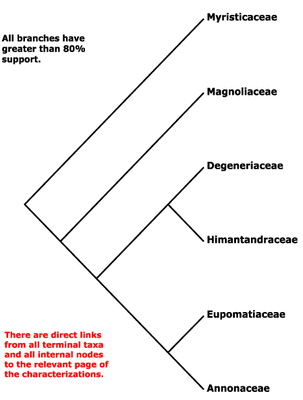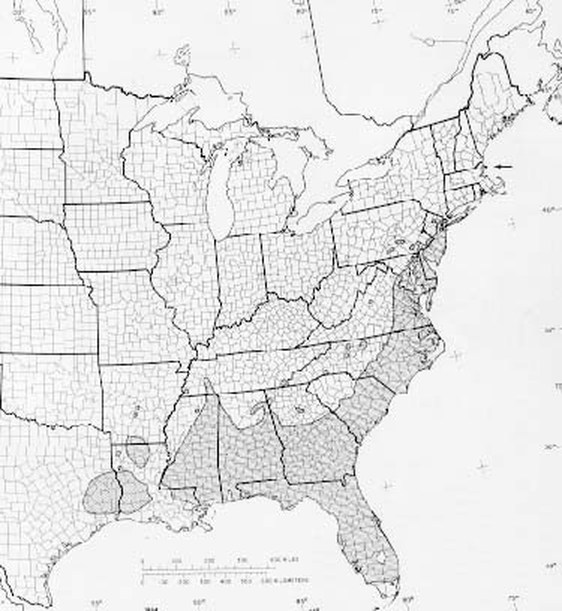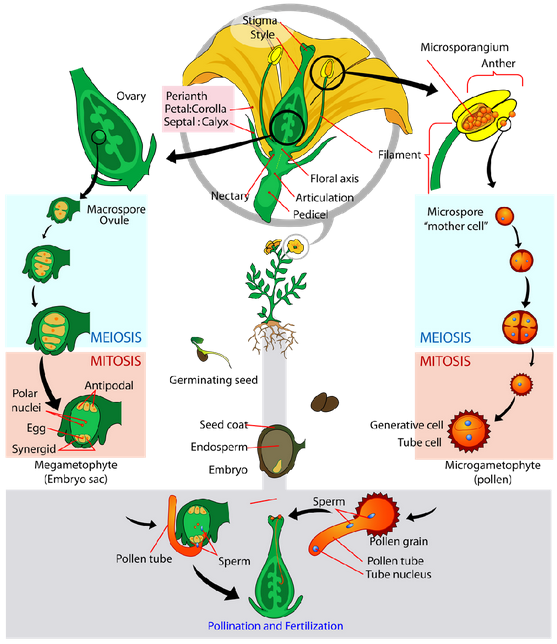 pic (3)
pic (3)
Natural History (6):
- Broad-leaved, semi evergreen shrub
- Leaves: alternate, simple, semi-evergreen to deciduous
- Flowers: creamy white, fragrant, blooms May-June
- Fruit: Red seed pods with bright red seeds showing September through October
- Growth: Medium growth rate. Mature height: 12-20’. Mature spread: 12-20’.
- Shade: Tolerates full shade; flowers best in partial shade.
- Habitat: forested wetlands, streams and pond borders, moist sandy woods.
- Range: southern New York, south to Florida and Texas.
Reproduction (1):
- Flowering and Fruiting-
- Fragrant perfect flowers; they are 5 to 7.5 cm (2 to 3 in) in diameter and 5 cm (2 in) deep
- Three pale sepals surround six to nine creamy white petals
- Inside the cup-shaped corolla are many stamens with purple bases, and within these stamens are many pistils spirally inserted on a spikelike receptacle
- The flowers are borne singly at the ends of branches and continue to open during a period of several weeks from April into July.
- Pollination is by insects
- The fruit is an ellipsoid or subglobose aggregate 2.5 to 5 cm (1 to 2 in) long and 1.25 to 3 cm (0.5 to 1.25 in) in diameter and consists of many one- or two-seeded follicles
- The fruits become ripe from July into October and are dull red, brownish red, or nearly green at maturity
- At maturity, the follicles burst open, and the 6 to 13 mm (0.25 to 0.5 in) long scarlet seeds emerge to hang suspended for a time by fine silky threads
- Sweetbays usually produce some fruit annually, but it is scarce
- Seed dispersal is by wind, birds, and occasionally by water and occurs soon after ripening
- Drupe-like seed: The outer portion of the outer seedcoat is fleshy, oily and soft; the inner portion is stony
- Sweetbay seeds show embryo dormancy that can be overcome by 3 to 6 months of low temperature stratification at 0° to 5° C
- Germination takes place above the ground
Seed Production and Dissemination-
Seedling Development-
Conservation Status:
- Sweet bay magnolia is endangered in Massachusetts and New York and threatened in Pennsylvania and Tennessee (7)
Interesting Facts:
- A favorite food of deer and cattle (1)
- The wood is soft, aromatic straight-grained: good for making veneer, boxes and containers (1)
- Often used in landscaping because of attractive flowers and foliage (1)
Summary of Research Article (8):
The research paper, Rapid Assessment of Genetic Variation for Morphological Traits in Sweetbay Magnolia Using a Container Production System revolved around the goal of providing diverse ornamental woody plant choices to meet specific needs for natural and constructed landscapes. To do this, it focused on true breeding and developing specific ideotypes of the woody plants. An ideotype is a plant with a desired appearance. In this scenario, Magnolia virginiana germplasm (collection of genetic resources for an organism) was used. An F1 (first filial generation of offspring of distinctly different parental types) half-sib family analysis of Magnolia virginiana generated from controlled pollinations was implemented to identify potential juvenile selection strategies for two mature ideotypes: a compact and rounded shrub form (to 2.5 m tall and wide) and a single-stemmed, small tree form (to 4 m tall), both with abundant flowering. The 2-year test was conducted in a container nursery. Fourteen traits were measured in 2007 and 2008, including height at three intervals (July, August, and September), mean branch length and branch count, early and late flower production, collar sprout formation, stem diameter, and branch angle. There were significant differences between F1half-sib families (P#0.0001) for all traits. Phenotypic and genetic correlations and narrow sense heritability were estimated for these traits. Narrow sense heritability is a measure of heritability, or the proportion of observable differences in a trait between individuals within a population that is due to genetic differences. Phenotypic and genetic correlations showed favorable associations among branch count, caliper, and early flower production. These traits were used to form a selection index for a shrub ideotype. Selection index is a method of artificial selection in which several useful traits are selected simultaneously. Also, there were positive phenotypic and genetic correlations between height and late flower production, which were both negatively correlated with collar sprout formation. These traits were used to form a selection index for the single-stemmed, small tree ideotype. Narrow sense heritabilities were high for most traits in 2007 but were lower in 2008. Results suggest that selection of phenotypes ranking highest for the traits of interest may yield the desired ideotypes. However, introduction of additional genetic variation through new germplasm accessions may be necessary to maintain breeding progress.
The research paper, Rapid Assessment of Genetic Variation for Morphological Traits in Sweetbay Magnolia Using a Container Production System revolved around the goal of providing diverse ornamental woody plant choices to meet specific needs for natural and constructed landscapes. To do this, it focused on true breeding and developing specific ideotypes of the woody plants. An ideotype is a plant with a desired appearance. In this scenario, Magnolia virginiana germplasm (collection of genetic resources for an organism) was used. An F1 (first filial generation of offspring of distinctly different parental types) half-sib family analysis of Magnolia virginiana generated from controlled pollinations was implemented to identify potential juvenile selection strategies for two mature ideotypes: a compact and rounded shrub form (to 2.5 m tall and wide) and a single-stemmed, small tree form (to 4 m tall), both with abundant flowering. The 2-year test was conducted in a container nursery. Fourteen traits were measured in 2007 and 2008, including height at three intervals (July, August, and September), mean branch length and branch count, early and late flower production, collar sprout formation, stem diameter, and branch angle. There were significant differences between F1half-sib families (P#0.0001) for all traits. Phenotypic and genetic correlations and narrow sense heritability were estimated for these traits. Narrow sense heritability is a measure of heritability, or the proportion of observable differences in a trait between individuals within a population that is due to genetic differences. Phenotypic and genetic correlations showed favorable associations among branch count, caliper, and early flower production. These traits were used to form a selection index for a shrub ideotype. Selection index is a method of artificial selection in which several useful traits are selected simultaneously. Also, there were positive phenotypic and genetic correlations between height and late flower production, which were both negatively correlated with collar sprout formation. These traits were used to form a selection index for the single-stemmed, small tree ideotype. Narrow sense heritabilities were high for most traits in 2007 but were lower in 2008. Results suggest that selection of phenotypes ranking highest for the traits of interest may yield the desired ideotypes. However, introduction of additional genetic variation through new germplasm accessions may be necessary to maintain breeding progress.


